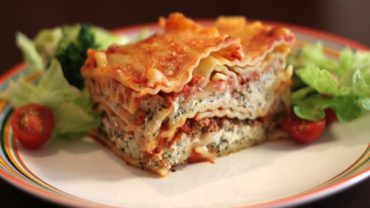via SFGATE: Lasagna represents a delicious comfort food for many, containing hearty noodles, rich cheese, flavorful tomato sauce, as well as a range of vegetables or meats. While the specific nutrient content of lasagna depends on the ingredients you use, most lasagnas have a number of nutrients in common.
Carbohydrates
One of the nutrients found in lasagna is carbohydrate – sugar and starch. Carbohydrates provide energy to your cells, helping to fuel their day-to-day functions. Most of the carbohydrates in your lasagna probably come from the noodles – a 2-ounce serving of white lasagna noodles contains around 40 grams of carbohydrates. To determine the specific carbohydrate content of your brand of lasagna noodles, check the nutrition label. A small amount of carbohydrates comes from the tomato sauce in your recipe, as well as from any vegetables you include.
Protein and Fat
Lasagna – particularly meat lasagna – also provides a source of dietary protein and fat. Your body breaks down protein into amino acids, and then uses these amino acids to maintain healthy tissue throughout your body. While the amount of protein in your lasagna will vary depending on how much meat and cheese you use in your recipe, each ounce of meat and mozzarella cheese adds 7.3 grams and 6.8 grams of protein to your lasagna, respectively. However, both ground beef and mozzarella cheese also provide rich sources of saturated fat, so limit their use in your lasagna.
Vitamins and Minerals
The pasta, meat, cheese and tomato sauce in lasagna all contain B vitamins, a group of nutrients that help drive your body’s metabolism; while beef in lasagna provides a source of iron to promote healthy circulation. Adding vegetables to your lasagna can further boost your nutrient intake – adding zucchini and red pepper, for example, adds vitamins A and C to your meal.
Making Healthier Lasagna
Although lasagna is far from a typical health food, you can make healthy substitutions at home to increase the nutritional value of your meal. Instead of making lasagna using white noodles – which digest rapidly, causing blood sugar spikes after eating – select whole-wheat noodles to help stabilize your blood sugar. If you make your lasagna with meat, select 95-percent lean ground beef or chicken, and rinse the meat after cooking to wash away excess fat. Limit your use of cheese, sprinkling only a small amount on top, and choose low-fat mozzarella to reduce your fat intake. Finally, load your lasagna up with vegetables to boost the fiber, vitamin and mineral content of your meal. If you don’t like the texture of vegetable pieces in your lasagna, try pureeing the cooked vegetables right into the tomato sauce before assembling your lasagna to get the nutritional benefits of vegetables without significantly changing the lasagna’s texture.



